From Unaware to Operational: The 5 Stages of AI Trust Maturity
TL;DR Most organizations are rushing into AI without the guardrails to ensure trust. This article breaks down the five stages of AI Trust maturity: Unaware, Aware, Emerging, Managed, and Operational, showing the risks and capabilities at each step, plus practical guidance on how to move forward. Readers will learn how to assess their current stage, what challenges to expect, and what it takes to turn AI from a compliance risk into a competitive advantage.


Get the Best of Data Leadership
Stay Informed
Get Data Insights Delivered
The bottom line: AI is moving faster than most organizations’ ability to govern it. Without the right trust infrastructure, the difference between breakthrough and breakdown comes down to luck.
Enterprises face real risks every day: exposing sensitive data, relying on third-party systems you can’t control, and making decisions from outputs you can’t fully trust. Yet AI is being deployed anyway—often without answering basic questions:
- What data is this agent using?
- Is that data reliable?
- Should this system have access to sensitive information?
The path from AI experimentation to operational excellence isn't linear, but it is predictable. Organizations move through five distinct stages of AI Trust maturity, each with its own challenges, capabilities, and risk profile. Knowing where you are on that path (and how to move forward) is what separates a competitive advantage from a compliance nightmare.
Trusting Your AI Agents
AI Trust is the confidence that your AI systems will behave reliably, responsibly, and within acceptable risk parameters. It's built on three foundational pillars:
Quality: Ensuring AI agents act on reliable, up-to-date, and accurate data inputs. This means having visibility into data freshness, completeness, and accuracy across all systems feeding AI applications.
Sensitivity: Controlling what data AI systems can access based on classification, privacy requirements, and business policies. This includes preventing unauthorized access to personally identifiable information, financial data, or other sensitive datasets.
Certification: Guaranteeing that AI systems use only approved datasets that have been validated for their intended purpose. This means having formal processes to evaluate and certify data as ready for AI consumption.
Traditional data governance wasn’t built for this. It assumed human queries, human pace, human intent. AI agents operate differently: they move fast, they scale wide, and they don’t ask permission before making their decisions. That’s where an AI Trust platform fits in.
The right platform doesn’t just help you meet today’s compliance checkboxes, it embeds these pillars into your daily operations. By making quality visible, sensitivity enforceable, and certification repeatable, it helps organizations move up the maturity curve faster. Instead of waiting years to evolve from ad hoc controls to full automation, you can accelerate the shift toward Operational, where trust is built-in and AI becomes a true advantage.
Where the Stages Fit In
Each stage represents a combination of capabilities, culture, and automation that determine how confidently an organization can deploy AI. The stages aren’t about “good” or “bad.” They’re a way to understand where you are today, what’s working for you now, and what’s possible as you mature.
Think of it as a ladder:
- Unaware → when AI risks aren’t on the radar yet
- Aware → when teams recognize the risks but scramble reactively
- Emerging → when structure starts to form but is uneven
- Managed → when governance and automation take hold
- Operational → when trust is fully built in and continuously improving
What matters is creating momentum. Each stage you climb doesn’t just reduce today’s risks, it sets you up to move faster, smarter, and with more confidence tomorrow.
The Five Stages of AI Trust Maturity
Stage 1: Unaware
"We don't know what we don't know about our AI data risks."
Organizations in the Unaware stage are often surprised to discover they're already here. They have no established processes for bringing data stakeholders together, rely on informal relationships for data decisions, and lack visibility into data quality dimensions. Most critically, they don't track or control how data flows into AI and machine learning projects.
What this looks like in practice:
- Teams use data in AI models without any certification process
- No visibility into which datasets power which AI applications
- Data quality issues are discovered when someone reports broken results
- Cross-functional collaboration happens through individual relationships, not structured processes
The usual wake-up call: A new AI application is producing unreliable results, but no one can quickly identify whether the problem stems from data quality, model drift, or access to inappropriate datasets. Resolution takes weeks because there's no systematic way to trace data lineage or understand downstream impact.
Key characteristic: AI initiatives proceed without data governance infrastructure, creating hidden risks that compound over time.
Stage 2: Aware
"We recognize the risks, but our responses are reactive and inconsistent."
Awareness typically comes from a data incident, regulatory requirement, or failed AI project. Organizations begin informal discussions about AI governance and start manual reviews of some datasets, but processes remain ad hoc and inconsistent across teams.
What this looks like in practice:
- Some teams manually review data before using it in AI projects, but there's no standard process
- Data quality issues are tracked informally by individuals or teams
- Basic monitoring exists with standard alerts, but detection is reactive
- Cross-functional working groups form around specific initiatives but lack permanent structure
Real-world scenario: A healthcare company's data team realizes their recommendation engine has been trained on outdated patient demographic data. They manually audit the affected datasets and implement basic quality checks, but each team develops its own approach. When similar issues arise in other departments, the solutions don't scale.
Key characteristic: Recognition of risk drives piecemeal solutions, but lack of standardization means problems recur across different teams and projects.
Stage 3: Emerging
"We're building systematic approaches, but implementation is still maturing."
Organizations begin formalizing their approach to AI data governance. They establish data governance committees, implement criteria for certifying AI-ready datasets, and start tracking key metrics. However, automation is limited and processes aren't yet fully integrated across the organization.
What this looks like in practice:
- Named AI governance council with defined but limited scope
- Standard categories for data classification (public, confidential, sensitive)
- Basic controls for AI/ML projects like approved tool lists or sign-off requirements
- Systematic tracking of data quality metrics for key datasets
Real-world scenario: A financial services firm creates an AI governance committee and develops criteria for certifying datasets as “AI-ready.” They validate data for their fraud detection system, documenting lineage and running manual quality checks. The process improves confidence but remains labor-intensive, and different business units interpret the certification criteria in inconsistent ways.
Key characteristic: Systematic approaches emerge, but inconsistent implementation across the organization limits scalability and effectiveness.
Stage 4: Managed
"We have established processes and governance, with increasing automation."
Organizations at the Managed stage have implemented comprehensive AI data governance programs. They maintain clear policies, automate key monitoring functions, and have established cross-functional accountability. Trust becomes measurable through standardized frameworks and regular reporting.
What this looks like in practice:
- Automated data quality monitoring across key systems with anomaly detection
- Clear data classification with standardized categories applied organization-wide
- Regular measurement of multiple data quality dimensions with trend analysis
- Documented ownership and automated assignment of data issues
- Centralized oversight of AI/ML data usage with access controls and audit logs
Real-world scenario: A manufacturing company’s AI Trust program monitors data freshness, completeness, and accuracy across all datasets feeding their predictive maintenance models. When a sensor data feed shows unusual patterns, the system automatically flags the issue and notifies the responsible team. Ownership is clear, accountability is documented, and remediation follows a defined process, though investigation and fixes still require manual intervention.
Key characteristic: Systematic governance with automation enables proactive risk management, but some processes still require manual intervention.
Stage 5: Operational
"AI Trust is embedded in our operations."
The Operational stage represents AI Trust as a core competency. Organizations have fully automated trust infrastructure with real-time monitoring, enforcement, and adaptation. AI systems operate within well-defined guardrails that automatically adapt based on risk assessments and policy changes.
What this looks like in practice:
- End-to-end automated lineage that supports auditing and impact analysis
- Policy-driven data classification with automated enforcement tied to usage controls
- Comprehensive AI data governance program covering sourcing, validation, lineage, use, and ongoing monitoring
- Dashboards and trend reporting that proactively identify issues and guide decision-making
- AI-ready data clearly marked and discoverable with full governance metadata
Real-world scenario: A technology company's AI Trust Platform automatically assesses every dataset for quality, sensitivity, and certification status before any AI system can access it. When a new marketing automation agent requests customer data, the platform instantly evaluates the request against privacy policies, data classification rules, and usage restrictions. Approved access includes automatic monitoring for unusual patterns, with trust scores updated in real-time and compliance reports generated automatically.
Key characteristic: Trust infrastructure operates as a seamless layer enabling rapid, confident AI deployment while maintaining full governance and compliance.
The Trust Infrastructure Gap
There’s currently a huge gap in tooling for enterprises, most of them don’t have the infrastructure to govern how AI systems access, use, and act on that data.
Traditional data governance tools, designed for human users making deliberate queries, struggle with the speed and autonomy of AI agents. A single AI system might access dozens of datasets, combine them in complex ways, and make thousands of decisions per minute. Without purpose-built trust infrastructure, even organizations with strong data governance can find themselves flying blind when AI enters the equation.
The regulatory reality: With frameworks like the EU AI Act and similar regulations advancing, organizations will need to demonstrate explainability and operate within defined risk boundaries. This requires moving beyond reactive monitoring to proactive governance.
Practical Steps for Advancing Your AI Trust Maturity
AI Trust maturity builds layer by layer: visibility, structure, and eventually, automation. Each stage reduces risk and clears the way for bigger, bolder AI initiatives.
That journey can feel daunting if you’re trying to piece it together alone. Our Professional Services team works with data leaders to assess current maturity, design practical roadmaps, and implement the foundations that let AI scale with confidence.
Here’s what progress typically looks like:
Unaware → Aware: Start with visibility. Work on understanding of the AI and ML applications already in play and the datasets powering them. Get the right people talking across teams so issues don’t stay buried.
Aware → Emerging: Put some structure around what’s been ad hoc. Form an oversight group, roll out a basic data classification scheme (think Public, Internal, Confidential, Restricted), and set initial criteria for what makes a dataset “AI-ready.”
Emerging → Managed: Standardize and automate. Move past one-off checks to consistent monitoring, apply your policies across the org, and assign clear ownership when problems show up.
Managed → Operational: Shift entirely away from manual fixes to well oiled systems. Automate enforcement, track lineage end-to-end, and build feedback loops so AI performance and data quality improve together.
The Strategic Imperative
AI can be a powerful business accelerator. Organizations that build robust trust infrastructure can move faster, take on more ambitious AI projects, and operate with confidence in regulated environments, leveraging data to outpace competitors. Those that don't will find themselves constantly managing crises, explaining failures, and limiting AI scope to avoid unacceptable risks, missing out on the benefits entirely.
The question isn't whether your organization will need AI Trust infrastructure, it's when.
As more enterprises recognize this reality, AI Trust platforms are emerging as a critical new layer in the AI stack, purpose-built to give organizations the visibility, control, and accountability they need to deploy AI systems confidently.
Learn more about how Bigeye's AI Trust Platform can accelerate your journey toward operational AI Trust maturity here.
Monitoring
Schema change detection
Lineage monitoring




.jpeg)


